Minimized Bolus-Type Wireless Sensor Node with a Built-In Three-Axis Acceleration Meter for Monitoring a Cow’s Rumen Conditions
Abstract
:1. Introduction
2. Materials and Methods
2.1. Design of the Wireless Sensor Node
2.2. Experimental Setup
3. Results
3.1. The Quasi-Test of the Rumen Atony
3.2. Compared Cow Behavior with Wireless Sensor Nodes Data
4. Discussion
5. Conclusions
Acknowledgments
Author Contributions
Conflicts of Interest
References
- Yun, C.-B.; Min, J. Smart sensing, monitoring, and damage detection for civil infrastructures. KSCE J. Civ. Eng. 2011, 15, 1–14. [Google Scholar] [CrossRef]
- Yamashita, T.; Okada, H.; Kobayashi, T.; Togashi, K.; Zymelka, D.; Takamatsu, S.; Itoh, T. Ultra-thin piezoelectric strain sensor array integrated on flexible printed circuit for structural health monitoring. IEEE Sens. J. 2016, 16, 8840–8846. [Google Scholar] [CrossRef]
- Hadjidj, A.; Souil, M.; Bouabdallaha, A.; Challala, Y.; Owenb, H. Wireless sensor networks for rehabilitation applications: Challenges and opportunities. J. Netw. Comput. Appl. 2013, 36, 1–15. [Google Scholar] [CrossRef]
- Díaz, S.E.; Pérez, J.C.; Mateos, A.C.; Marinescu, M.; Guerra, B.B. A novel methodology for the monitoring of the agricultural production process based on wireless sensor networks. Comput. Electron. Agric. 2011, 76, 252–265. [Google Scholar] [CrossRef]
- Nishihara, K.; Iwasaki, W.; Nakamura, M.; Higurashi, E.; Soh, T.; Itoh, T.; Okada, H.; Maeda, R.; Sawada, R. Development of a wireless sensor for the measurement of chicken blood flow using the laser Doppler blood flow meter technique. IEEE Trans. Biomed. Eng. 2013, 60, 1645–1653. [Google Scholar] [CrossRef] [PubMed]
- Okada, H.; Itoh, T.; Suzuki, K.; Tsukamoto, K. Wireless sensor systems for detection of avian influenza outbreak farms at an early stage. In Proceedings of the IEEE Sensors 2009, Christchurch, New Zealand, 25–28 October 2009; pp. 1374–1377. [Google Scholar]
- Okada, H.; Itoh, T.; Masuda, T. Development of custom CMOS LSI for ultra-low power wireless sensor node in health monitoring systems. In Proceedings of the IEEE Sensors 2011, Limerick, Ireland, 28–31 October 2011; pp. 1197–2000. [Google Scholar]
- Nogami, H.; Okada, H.; Miyamoto, T.; Maeda, R.; Itoh, T. Wearable and compact wireless sensor nodes for measuring in temperature of the base of a calf’s tail. Sens. Mater. 2013, 25, 577–582. [Google Scholar]
- Nogami, H.; Okada, H.; Miyamoto, T.; Maeda, R.; Itoh, T. Wearable wireless temperature sensor nodes appressed to base of a calf's tail. Sens. Mater. 2014, 26, 539–545. [Google Scholar]
- Andersson, L.M.; Okada, H.; Miura, R.; Zhang, Y.; Yoshioka, K.; Aso, H.; Itoh, T. Wearable wireless estrus detection sensor for cows. Comput. Electron. Agric. 2016, 127, 101–108. [Google Scholar] [CrossRef]
- Iwasaki, W.; Sathuluri, R.R.; Niwa, O.; Miyazaki, M. Influence of Contact Force on Electrochemical Responses of Redox Species Flowing in Nitrocellulose Membrane at Micropyramid Array Electrode. Anal. Sci. 2015, 31, 729–732. [Google Scholar] [CrossRef] [PubMed]
- Plaizier, J.C.; Krause, D.O.; Gozho, G.N.; McBride, B.W. Subacute ruminal acidosis in dairy cows: The physiological causes, incidence and consequences. Vet. J. 2008, 176, 21–31. [Google Scholar] [CrossRef] [PubMed]
- Mulligan, F.J.; Doherty, M.L. Production diseases of the transition cow. Vet. J. 2008, 176, 3–9. [Google Scholar] [CrossRef] [PubMed]
- Enemark, J. The monitoring, prevention and treatment of sub-acute ruminal acidosis (SARA): A review. Vet. J. 2008, 176, 32–43. [Google Scholar] [CrossRef] [PubMed]
- Sato, S.; Mizuguchi, H.; Ito, K.; Ikuta, K.; Kimura, A.; Okada, K. Technical note: Development and testing of a radio transmission pH measurement system for continuous monitoring of ruminal pH in cows. Prev. Vet. Med. 2012, 103, 274–279. [Google Scholar] [CrossRef] [PubMed]
- Sato, S.; Kimura, A.; Anan, T.; Yamagishi, N.; Okada, K.; Mizuguchi, H.; Ito, K. A radio transmission pH measurement system for continuous evaluation of fluid pH in the rumen of cows. Vet. Res. Commun. 2012, 36, 85–89. [Google Scholar] [CrossRef] [PubMed]
- Colvin, H.W.; Horn, G.W. The significance of ruminal motility in the etiology of bloat. In Proceedings of the National Wheat Pasture Symposium; Oklahoma Agricultural Experimental Station: Stillwater, OK, USA, 1984; pp. 165–195. [Google Scholar]
- Hara, S.; Takahashi, K.; Tomizawa, N.; Nakashima, Y.; Sasaki, N.; Jorgensen, R.J. Effects of fasting and xylazine sedative on digestive tract motility, rumen VFA and certain blood components in ruminants. Veterinarija Zootechnika 2002, 19, 5–14. [Google Scholar]
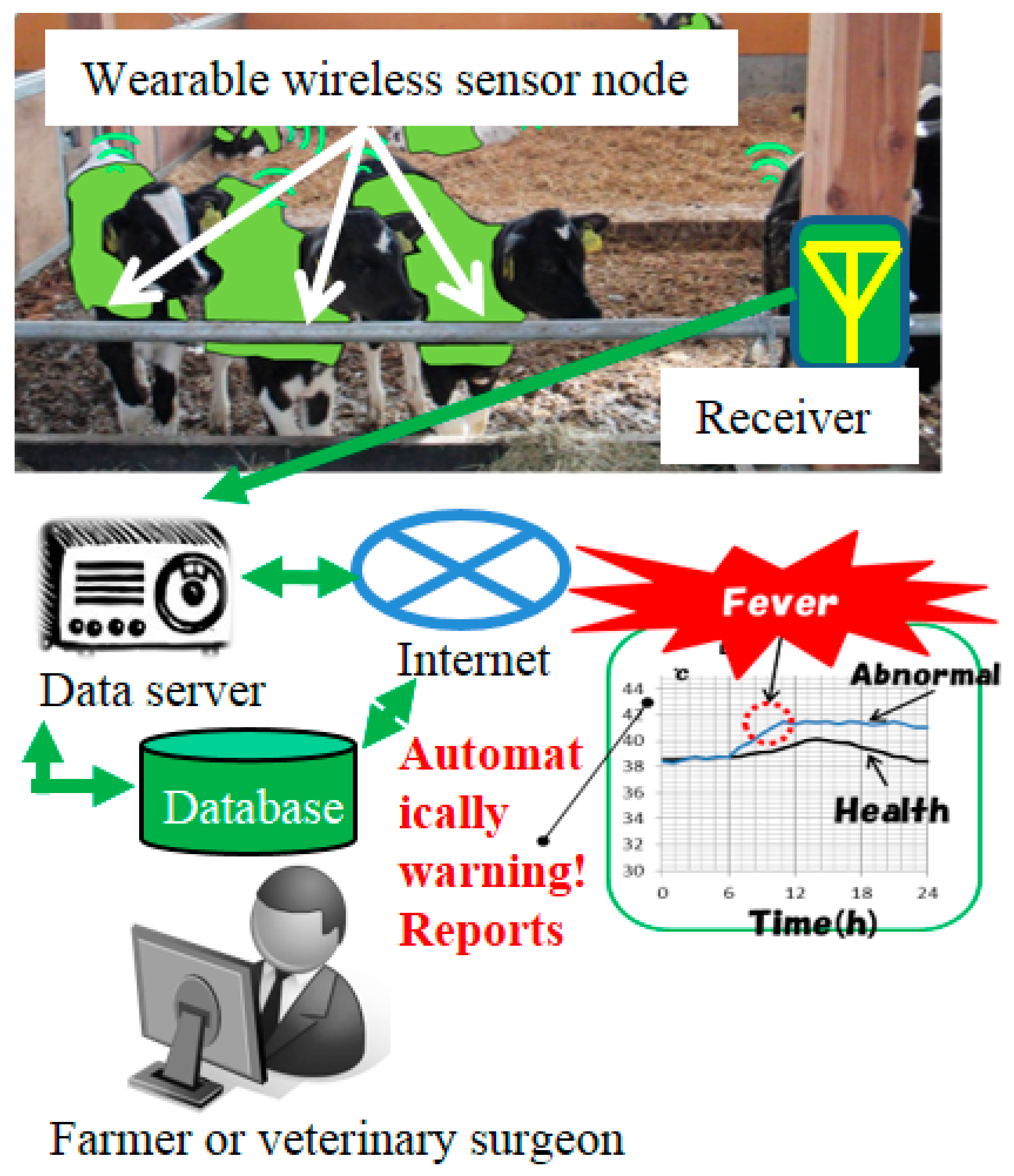


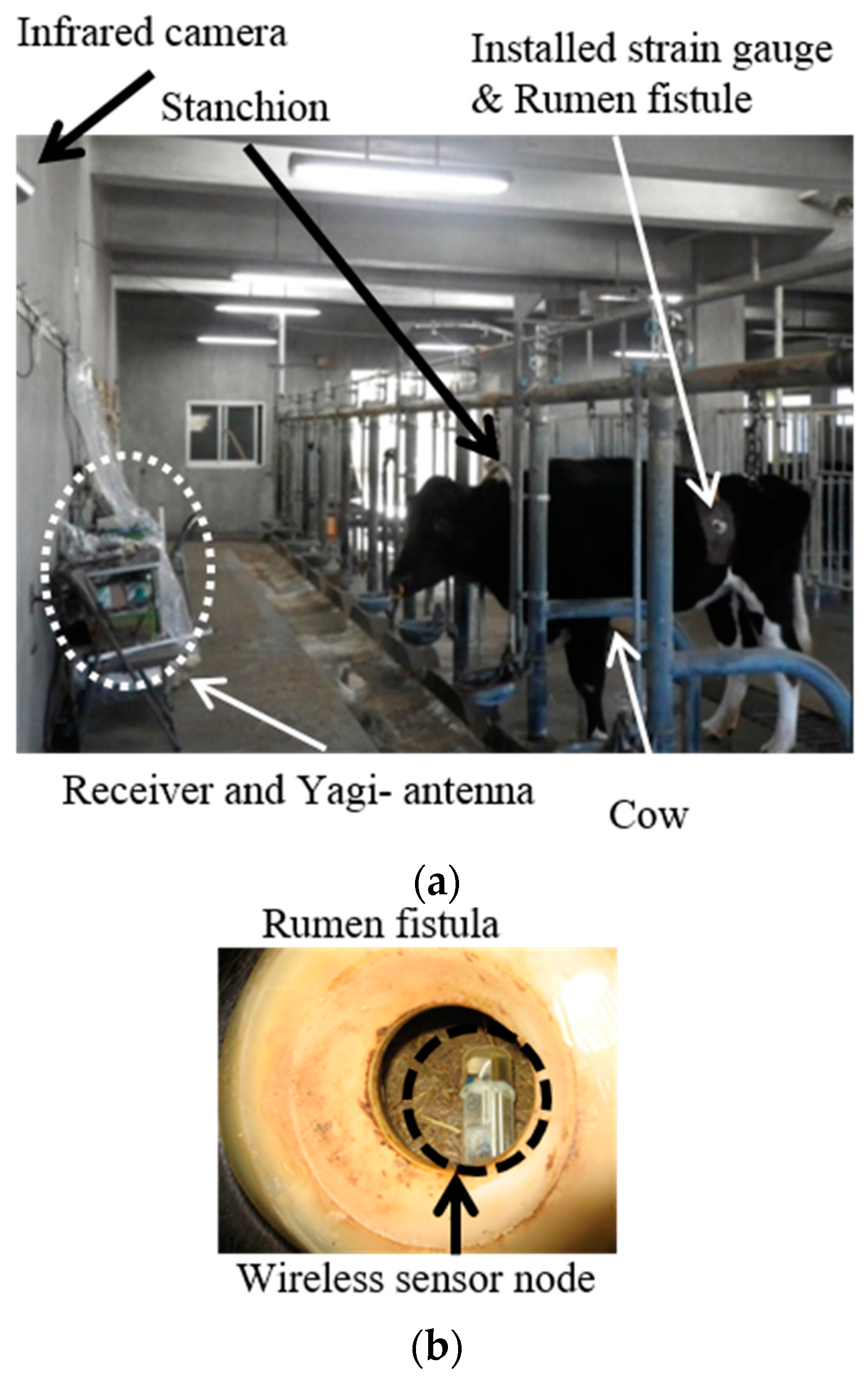
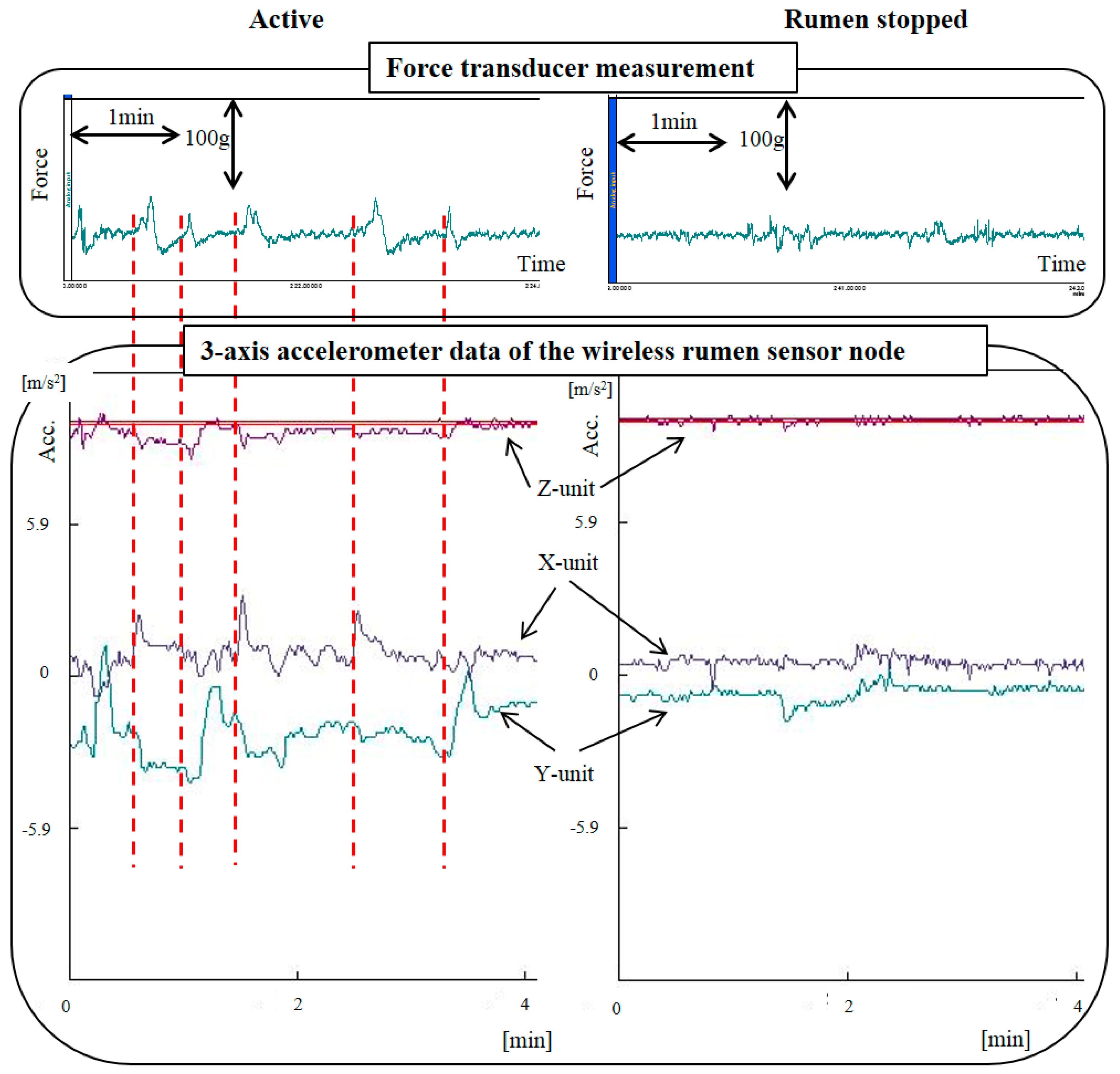
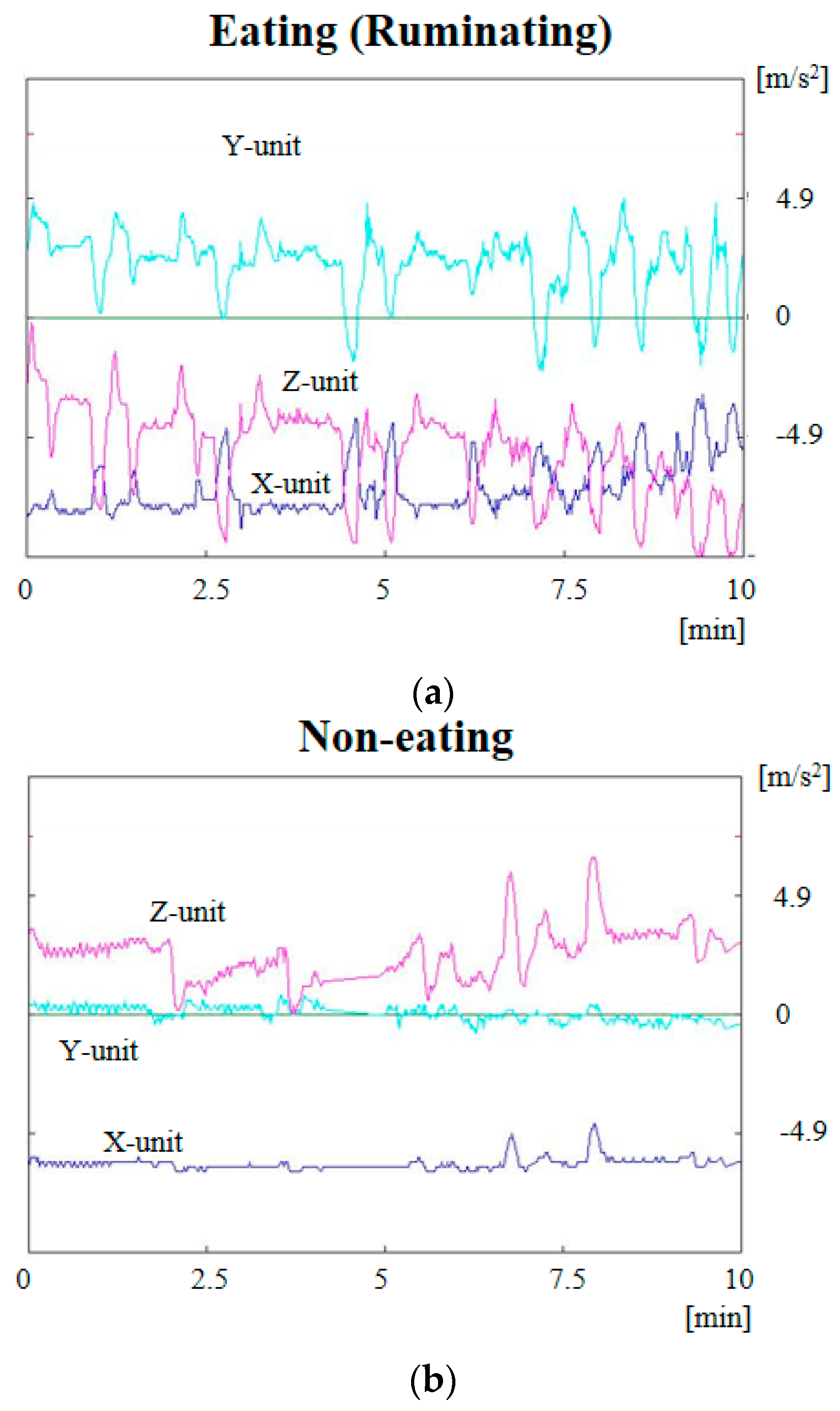
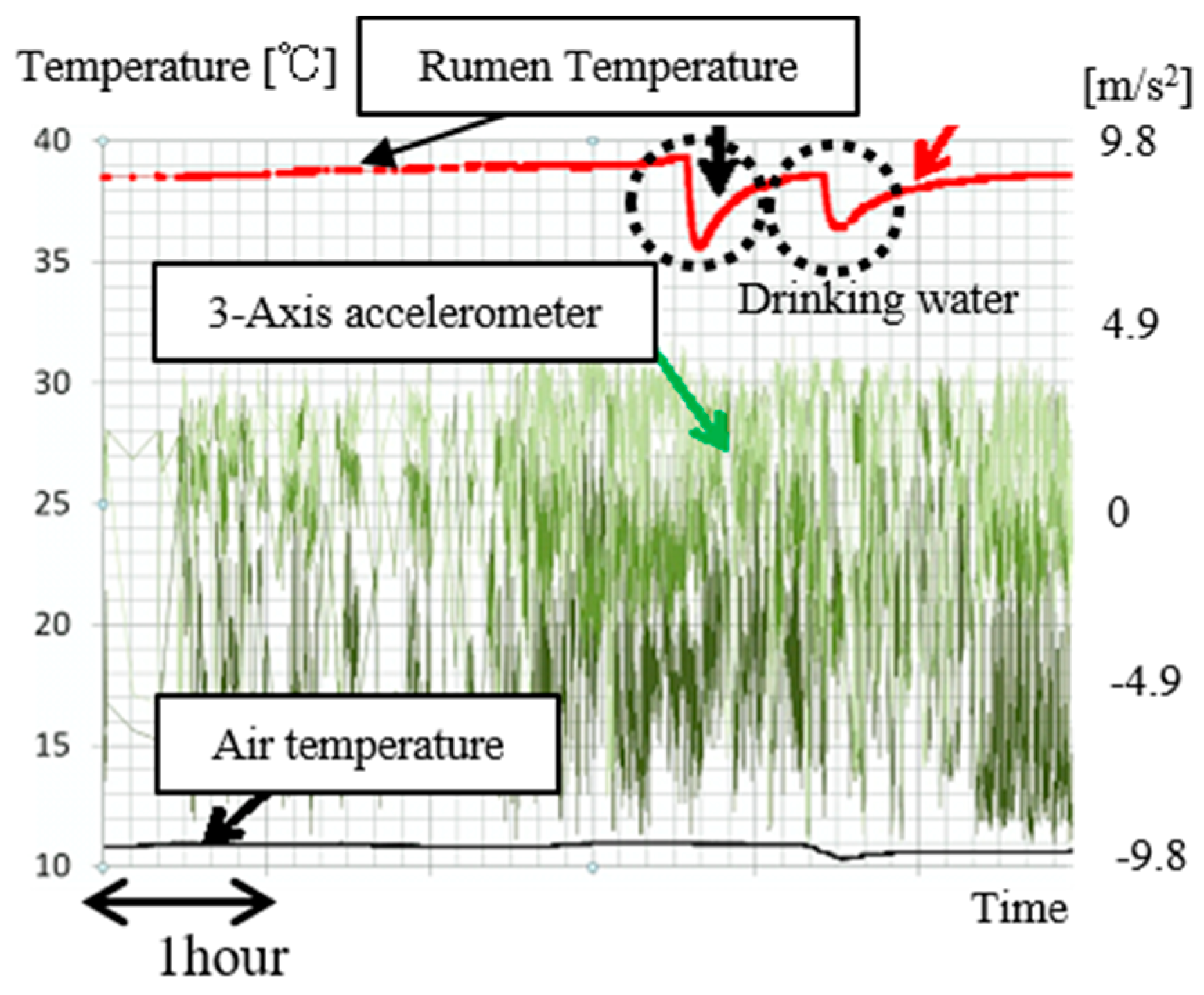

© 2017 by the authors. Licensee MDPI, Basel, Switzerland. This article is an open access article distributed under the terms and conditions of the Creative Commons Attribution (CC BY) license (http://creativecommons.org/licenses/by/4.0/).
Share and Cite
Nogami, H.; Arai, S.; Okada, H.; Zhan, L.; Itoh, T. Minimized Bolus-Type Wireless Sensor Node with a Built-In Three-Axis Acceleration Meter for Monitoring a Cow’s Rumen Conditions. Sensors 2017, 17, 687. https://doi.org/10.3390/s17040687
Nogami H, Arai S, Okada H, Zhan L, Itoh T. Minimized Bolus-Type Wireless Sensor Node with a Built-In Three-Axis Acceleration Meter for Monitoring a Cow’s Rumen Conditions. Sensors. 2017; 17(4):687. https://doi.org/10.3390/s17040687
Chicago/Turabian StyleNogami, Hirofumi, Shozo Arai, Hironao Okada, Lan Zhan, and Toshihiro Itoh. 2017. "Minimized Bolus-Type Wireless Sensor Node with a Built-In Three-Axis Acceleration Meter for Monitoring a Cow’s Rumen Conditions" Sensors 17, no. 4: 687. https://doi.org/10.3390/s17040687




